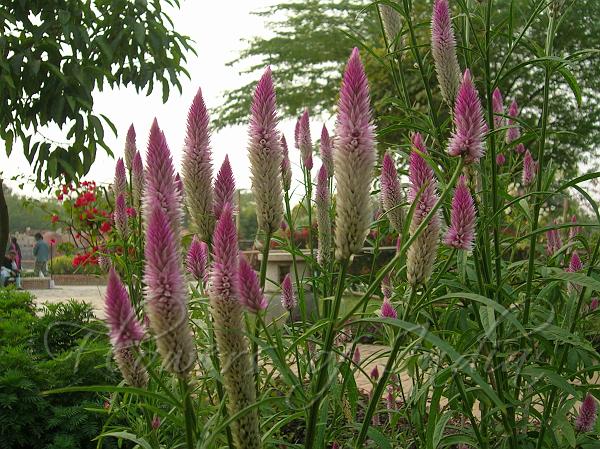|
| Silver Cockscomb |
|

|

| File size | 1076884 |
| Original date | 12/10/06 3:01 PM |
| Resolution | 2048 x 1536 |
| Flash | Flash did not fire, auto |
| Focal length | 8.0mm |
| Exposure time | 1/274s |
| Aperture | 3.2 |
| Focus Distance | |
| Metering Mode | Partial |
| Camera make | NIKON |
| Camera model | E3700 |
| Sensor type |
|
|
|
|
Photo: |
Botanical name: Celosia argentea Family: Amaranthaceae (Amaranth family)
Synonyms: Celosia japonica, Celosia stricta, Celosia plumosa
Synonyms: Celosia japonica, Celosia stricta, Celosia plumosa
Silver cockscombs are erect, branching plants, 60-75
cm tall, with narrow-elliptic or lance-shaped, strongly veined leaves
5-15 cm long, and hundreds of tiny flowers packed in dense spikes of
silver-white flowers which usually stand above the foliage. They are
beautiful plants with soft, dense feathery spikes, produced in
profusion. Wonderful straw-like flower when dried. It offers fresh
shape and colour to cut flower, or everlasting flower arrangements,
with 10-13 cm flower spikes on 60 cm stems. Slender, cylindrical pink
or rose flowerheads have a metallic sheen because the individual
flowers are silvery-white at their bases. Silver Cockscomb is found in
India, W-E Nepal, Bhutan, SE Asia, China, Japan, Korea,
Tropical Africa, at altitudes of 500-1600 m. It is also found in the
Himalayas and Western Ghats.
Medicinal uses: The flowers and seed are astringent, haemostatic, ophthalmic, parasiticide
and poultice. They are used in the treatment of bloody stool, haemorrhoid
bleeding, uterine bleeding, leucorrhoea, dysentery and diarrhoea. As
a parasiticide it is very effective against Trichomonas, a 20% extract
can cause the Trichomonas to disappear in 15 minutes. The seed is
hypotensive and ophthalmic. It is used in the treatment of diarrhoea,
bloodshot eyes, blurring of vision, cataracts and hypertension, but should
not be used by people with glaucoma because it dilates the pupil. The
seeds are widely used in India for the treatment of diabetes mellitus.
The flowers and seed are astringent, haemostatic, ophthalmic, parasiticide
and poultice. They are used in the treatment of bloody stool, haemorrhoid
bleeding, uterine bleeding, leucorrhoea, dysentery and diarrhoea. As
a parasiticide it is very effective against Trichomonas, a 20% extract
can cause the Trichomonas to disappear in 15 minutes. The seed is
hypotensive and ophthalmic. It is used in the treatment of diarrhoea,
bloodshot eyes, blurring of vision, cataracts and hypertension, but should
not be used by people with glaucoma because it dilates the pupil. The
seeds are widely used in India for the treatment of diabetes mellitus.
Medicinal uses:
 The flowers and seed are astringent, haemostatic, ophthalmic, parasiticide
and poultice. They are used in the treatment of bloody stool, haemorrhoid
bleeding, uterine bleeding, leucorrhoea, dysentery and diarrhoea. As
a parasiticide it is very effective against Trichomonas, a 20% extract
can cause the Trichomonas to disappear in 15 minutes. The seed is
hypotensive and ophthalmic. It is used in the treatment of diarrhoea,
bloodshot eyes, blurring of vision, cataracts and hypertension, but should
not be used by people with glaucoma because it dilates the pupil. The
seeds are widely used in India for the treatment of diabetes mellitus.
The flowers and seed are astringent, haemostatic, ophthalmic, parasiticide
and poultice. They are used in the treatment of bloody stool, haemorrhoid
bleeding, uterine bleeding, leucorrhoea, dysentery and diarrhoea. As
a parasiticide it is very effective against Trichomonas, a 20% extract
can cause the Trichomonas to disappear in 15 minutes. The seed is
hypotensive and ophthalmic. It is used in the treatment of diarrhoea,
bloodshot eyes, blurring of vision, cataracts and hypertension, but should
not be used by people with glaucoma because it dilates the pupil. The
seeds are widely used in India for the treatment of diabetes mellitus.
| Identification credit: Tabish | Photographed in Delhi & Imphal. |
• Is this flower misidentified? If yes,